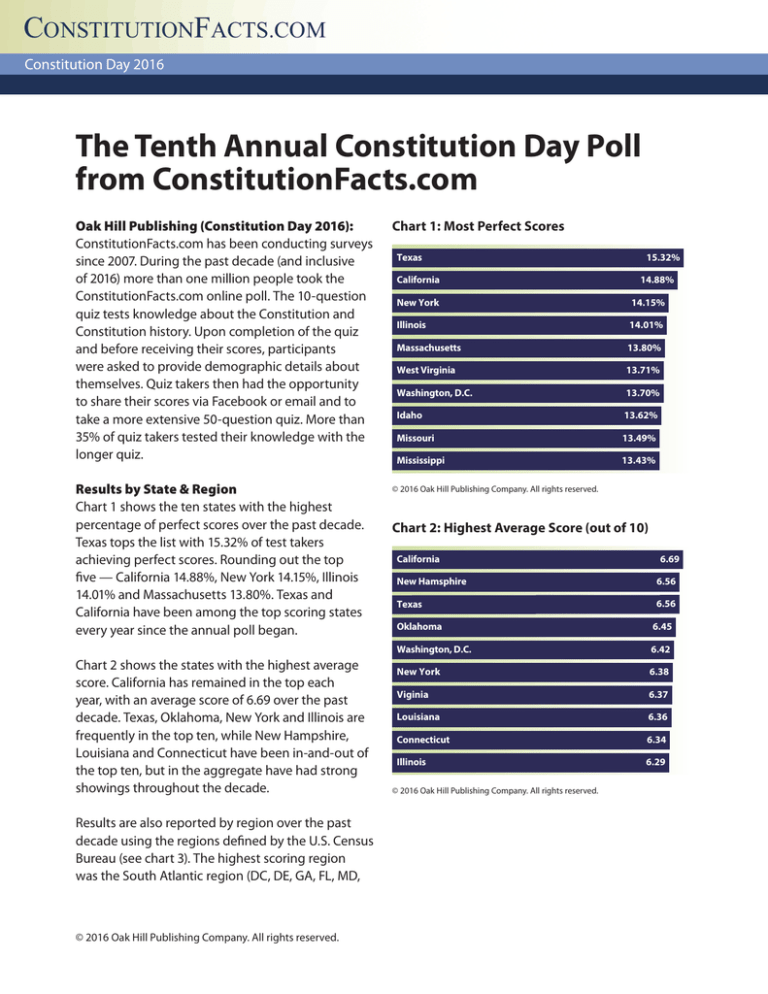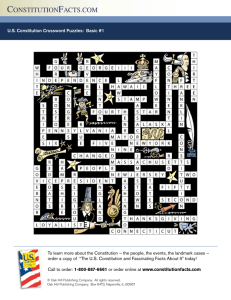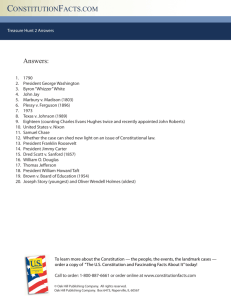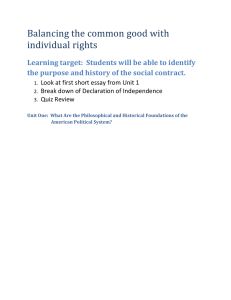
CONSTITUTIONFACTS.COM
Constitution Day 2016
The Tenth Annual Constitution Day Poll
from ConstitutionFacts.com
Oak Hill Publishing (Constitution Day 2016):
ConstitutionFacts.com has been conducting surveys
since 2007. During the past decade (and inclusive
of 2016) more than one million people took the
ConstitutionFacts.com online poll. The 10-question
quiz tests knowledge about the Constitution and
Constitution history. Upon completion of the quiz
and before receiving their scores, participants
were asked to provide demographic details about
themselves. Quiz takers then had the opportunity
to share their scores via Facebook or email and to
take a more extensive 50-question quiz. More than
35% of quiz takers tested their knowledge with the
longer quiz.
Chart 1: Most Perfect Scores
Results by State & Region
Chart 1 shows the ten states with the highest
percentage of perfect scores over the past decade.
Texas tops the list with 15.32% of test takers
achieving perfect scores. Rounding out the top
five — California 14.88%, New York 14.15%, Illinois
14.01% and Massachusetts 13.80%. Texas and
California have been among the top scoring states
every year since the annual poll began.
© 2016 Oak Hill Publishing Company. All rights reserved.
Chart 2 shows the states with the highest average
score. California has remained in the top each
year, with an average score of 6.69 over the past
decade. Texas, Oklahoma, New York and Illinois are
frequently in the top ten, while New Hampshire,
Louisiana and Connecticut have been in-and-out of
the top ten, but in the aggregate have had strong
showings throughout the decade.
Results are also reported by region over the past
decade using the regions defined by the U.S. Census
Bureau (see chart 3). The highest scoring region
was the South Atlantic region (DC, DE, GA, FL, MD,
© 2016 Oak Hill Publishing Company. All rights reserved.
Texas
California
15.32%
14.88%
New York
14.15%
Illinois
14.01%
Massachusetts
13.80%
West Virginia
13.71%
Washington, D.C.
13.70%
Idaho
13.62%
Missouri
13.49%
Mississippi
13.43%
Chart 2: Highest Average Score (out of 10)
California
6.69
New Hamsphire
6.56
Texas
6.56
Oklahoma
6.45
Washington, D.C.
6.42
New York
6.38
Viginia
6.37
Louisiana
6.36
Connecticut
6.34
Illinois
6.29
© 2016 Oak Hill Publishing Company. All rights reserved.
CONSTITUTIONFACTS.COM
Constitution Day 2016
NC, SC, VA, WV). It excludes three of the highest
scoring states — Texas (West South Central Region),
California — (Pacific Region), and New York (Middle
Atlantic Region).
In past years the South Atlantic region (DC, DE,
GA, FL, MD, NC, SC, VA, WV) has been in the
middle of the pack, but recent increases in annual
performance have provided a first place finish over
the past decade. The Pacific region (AK, CA, HI, OR,
WA) has been a perennial best performer due to
California. The Middle Atlantic region (NY, NJ, PA)
has remained in the middle of the pack due to New
York’s consistently high results. The New England
region (CT, VT, NH, ME, MA, RI) — a high scorer in
most years — moved from fifth to third place over
the past decade.
Surprising Trends
Knowledge about the Bill of Rights — the first 10
Amendments to the Constitution — remains one of
the highest scoring areas of knowledge about the
Constitution. The two highest scoring questions on
the 10-question quiz (questions #3 and #5) are both
about the Bill of Rights (see chart 4). And the five
questions about the Bill of Rights in the 50-question
quiz also were among the highest scoring questions
(four out of five were answered correctly more than
70% of the time and all were answered correctly
over 65% of the time).
The average age of test-takers was twenty-three.
50% were male, 50% were female. In past years,
participants over 51 and between ages 36 and
50 scored almost the same, with participants
between ages 18 and 35 scoring slightly lower and
participants 17 and under scoring lowest. This year
participants between ages 36 and 50 have edged
farther ahead than participants over age 51 (see
chart 5).
© 2016 Oak Hill Publishing Company. All rights reserved.
Chart 3: Average Regional Scores (out of 10)
South Atlantic (DC, DE, GA, FL, MD, NC, SC, VA, WV)
6.73
Pacific (AK, CA, HI, OR, WA)
6.64
New England (CT, MA, ME, NH, RI, VT)
6.61
East North Central (IL, IN, MI, OH, WI)
6.53
Middle Atlantic (NJ, NY, PA)
6.52
Mountain (AZ, CO, ID, MT, NM, NV, UT, WY)
6.51
East South Central (AL, KY, MS, TN)
6.47
West South Central (AR, LA, OK, TX)
6.46
West North Central (IA, KS, MO, MN, ND, NE, SD)
6.41
© 2016 Oak Hill Publishing Company. All rights reserved.
Chart 4: How Did Americans Fare?
Number of U.S. Constitutions enacted
61.5%
The Role of Congress
71.5%
First 10 Amendments are the Bill of Rights
Convicted of treason
93.5%
38.5%
Pleading the fifth
80.5%
President/VP different parties
1st President under Articles
48%
41%
VP and 25th Amendment
Laws Congress can make
54.5%
34.5%
Minimum age to be a U.S. Senator
© 2016 Oak Hill Publishing Company. All rights reserved.
71%
6.54
national
average
CONSTITUTIONFACTS.COM
ONSTITUTION
C
FACTS.COM
Constitution
Day 2016
Common Misconceptions about the
Constitution
While knowledge of the Bill of Rights remains
high, other areas of Constitution knowledge are
much less consistent. In particular, many of the
questions that were answered correctly least often
concerned the powers of the federal government.
The fewest people were able to answer question
#9 correctly, “What kind of laws can Congress
make?” The correct answer is: “Any laws that are
necessary and proper for executing the powers
of the federal government.” This answer comes
directly from Article I, Section 8 of the Constitution.
The final clause of that section says that Congress
has the power “to make all Laws which shall be
necessary and proper for carrying into Execution the
foregoing Powers, and all other Powers vested by
this Constitution in the Government of the United
States, or in any Department or Officer thereof.”
This clause is sometimes called the “elastic clause”
because it gives Congress the flexibility to make laws
not described specifically in the Constitution.
Question #34 of the 50-question quiz “Which Article
of the Constitution lists the primary powers of
Congress?” was among the lowest scoring questions
over the past decade (answered correctly only
37.5% of the time). The correct answer is A: “Article
1” which describes the Legislative Branch, including
both houses of Congress and all of their powers.
Other low-scoring questions regarding the current
powers of the federal government as defined by
the Constitution included question #50 about the
number of votes required to pass a Constitutional
Amendment (answered correctly only 35% of the
time), question #39 asking the number of Supreme
Court Justices required by the Constitution
(answered correctly only 38% of the time), and
question #32 about the so-called “supremacy clause”
of the Constitution which establishes the supremacy
of federal laws over conflicting state or local laws
(answered correctly only 40.5% of the time over the
© 2016 Oak Hill Publishing Company. All rights reserved.
Chart 5: Scores by Age Group
10
Chart
5: Scores by Age Group
10
8
8
6
6.65
6.65
7.04
7.56
7.44
7.04
7.56
7.44
18–35
36–50
51-plus
6
4
4
2
2
17 & Under
© 2016 Oak Hill Publishing Company. All rights reserved.
17 & Under
18–35
36–50
51-plus
© 2016 Oak Hill Publishing Company. All rights reserved.
past decade). The correct answers to these three
questions are:
• •
•
•
Three quarters of the states must approve a
Constitutional Amendment. Three quarters of 50 states is 37.5, so 37 states cannot approve an Amendment but 38 can.
The Constitution does not establish the number
of Supreme Court justices. Instead, the Constitution gives Congress the power to determine the number of justices.
The “Supremacy Clause” of the Constitution states that any state or local law that directly conflicts with a valid federal law is void.
The Supremacy Clause is the common name given to Article VI, Section 2 of the U.S.
Constitution. It declares that the “Constitution,
and the Laws of the United States . . . shall be the
supreme Law of the Land.”
Chart 6 on the following page shows detailed results
for the 50-question quiz.
For more information about the Constitution,
or to take the Constitution IQ quiz, visit
For more information about the Constitution,
www.ConstitutionFacts.com.
or to take the Constitution IQ quiz, visit
www.ConstitutionFacts.com.
CONSTITUTIONFACTS.COM
Constitution Day 2016
Chart 6: 50-Question Expanded Quiz Scoring (Expert Quiz #2 — ConstitutionFacts.com)
25th Amendment provides right to vote
Congress is the rulemaker
61.5%
50%
Case establishing judicial review
67.5%
Freedoms guaranteed by 1st Amendment
67%
Father of Constitution is Madison
56.5%
Bill of Rights 1st 10 Amendments
No mention VP paid by public funds
55.5%
# Amendments in Constitution
States chose who attended Convention
73.5%
Constitution Day is September 17th
Third in line to serve
Supremacy clause
78%
67.5%
Term of office for House of Reps
67%
1st Amendment guarantees freedom of speech
435 members of the House of Reps
75.5%
74.5%
70%
38%
# of Amendments repealed
Washington presided convention
47.5%
Nine states ratified the Constitution
Speaker of the House
82%
Separation of powers
Sessions of Congress
53.5%
51.5%
82.5%
84%
71%
51.5%
38%
Art. 1 legislative branch
54.5%
Right to public education not mentioned
Power to impeach
53.5%
Term for Chief Justice
Art. 2 grants powers of the President
Population determines # of House seats
Criteria for running for President
65%
76.5%
65.5%
6th ammendment guarantees speedy trial
Votes for Amendment
67.5%
77%
Electoral College
80.5%
66.5%
53.5%
Cabinet positions
Legislative branch makes the laws
2 Senators for each state
68.5%
Method for selecting federal court judges
Sage of Constitution Convention
76.5%
Length of term for Senator
37.5%
# Supreme Court Justices
60.5%
Date and location for Convention
52.5%
Government based on Federalism
70.5%
Min. age for House of Reps member
Separation of powers
Congress has legislative powers
74.5%
VP presides over Senate
80.5%
40.5%
Powers of Congress
72.5%
Number of Senators
82.5%
Bill of Rights protects individual rights
63.5%
Case that declared segregation unconstitutional
84.5%
Checks and balances
68.5%
VP must be at least 35 to serve
92%
73.5%
35%
© 2016 Oak Hill Publishing Company. All rights reserved.
To learn more about the Constitution — the people, the events, the landmark cases —
order a copy of “The U.S. Constitution and Fascinating Facts About It” today!
Call to order: 1-800-887-6661 or order online at www.ConstitutionFacts.com
© Oak Hill Publishing Company. All rights reserved.
Oak Hill Publishing Company. Box 6473, Naperville, IL 60567






